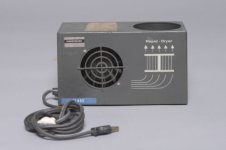I can't speak for any other models, but my Senrac has a cool/warm switch, and only on the warm setting does it actually heat the air. So no need to bake your film if you don't want to! 🙂 So far I haven't needed to use the heat even once, as the film has always been completely dry after one full cycle of the timer (~15 minutes) using the cool setting. This is with single rolls of 120 film on stainless steel reels; and I do live in a rather dry climate - so your mileage may vary.
But just for reference, here are my measurements. On the warm setting, the Senrac's air temperature rose by about 40F from a room temperature of 70F, settling in at about 110F. For good measure I also checked the cool setting and found that the temperature still increases, but only slighty - rising by about 3-4F (presumably just heating of the air from operation of the blower).
Hope that helps!
Jeff


